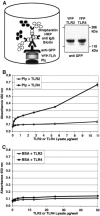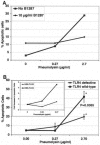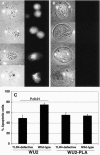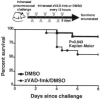The apoptotic response to pneumolysin is Toll-like receptor 4 dependent and protects against pneumococcal disease
- PMID: 16177320
- PMCID: PMC1230904
- DOI: 10.1128/IAI.73.10.6479-6487.2005
The apoptotic response to pneumolysin is Toll-like receptor 4 dependent and protects against pneumococcal disease
Abstract
Pneumolysin, the cholesterol-dependent cytolysin of Streptococcus pneumoniae, induces inflammatory and apoptotic events in mammalian cells. Toll-like receptor 4 (TLR4) confers resistance to pneumococcal infection via its interaction with pneumolysin, but the underlying mechanisms remain to be identified. In the present study, we found that pneumolysin-induced apoptosis is also mediated by TLR4 and confers protection against invasive disease. The interaction between TLR4 and pneumolysin is direct and specific; ligand-binding studies demonstrated that pneumolysin binds to TLR4 but not to TLR2. Involvement of TLR4 in pneumolysin-induced apoptosis was demonstrated in several complementary experiments. First, macrophages from wild-type mice were significantly more prone to pneumolysin-induced apoptosis than cells from TLR4-defective mice. In gain-of-function experiments, we found that epithelial cells expressing TLR4 and stimulated with pneumolysin were more likely to undergo apoptosis than cells expressing TLR2. A specific TLR4 antagonist, B1287, reduced pneumolysin-mediated apoptosis in wild-type cells. This apoptotic response was also partially caspase dependent as preincubation of cells with the pan-caspase inhibitor zVAD-fmk reduced pneumolysin-induced apoptosis. Finally, in a mouse model of pneumococcal infection, pneumolysin-producing pneumococci elicited significantly more upper respiratory tract cell apoptosis in wild-type mice than in TLR4-defective mice, and blocking apoptosis by administration of zVAD-fmk to wild-type mice resulted in a significant increase in mortality following nasopharyngeal pneumococcal exposure. Overall, our results strongly suggest that protection against pneumococcal disease is dependent on the TLR4-mediated enhancement of pneumolysin-induced apoptosis.
Figures





References
-
- Ali, F., M. E. Lee, F. Iannelli, G. Pozzi, T. J. Mitchell, R. C. Read, and D. H. Dockrell. 2003. Streptococcus pneumoniae-associated human macrophage apoptosis after bacterial internalization via complement and Fcgamma receptors correlates with intracellular bacterial load. J. Infect. Dis. 188:1119-1131. - PubMed
-
- Aliprantis, A. O., R. B. Yang, M. R. Mark, S. Suggett, B. Devaux, J. D. Radolf, G. R. Klimpel, P. Godowski, and A. Zychlinsky. 1999. Cell activation and apoptosis by bacterial lipoproteins through Toll-like receptor-2. Science 285:736-739. - PubMed
-
- Arditi, M., E. O. Mason, Jr., J. S. Bradley, T. Q. Tan, W. J. Barson, G. E. Schutze, E. R. Wald, L. B. Givner, K. S. Kim, R. Yogev, and S. L. Kaplan. 1998. Three-year multicenter surveillance of pneumococcal meningitis in children: clinical characteristics, and outcome related to penicillin susceptibility and dexamethasone use. Pediatrics 102:1087-1097. - PubMed
-
- Aronin, S. I., P. Peduzzi, and V. J. Quagliarello. 1998. Community-acquired bacterial meningitis: risk stratification for adverse clinical outcome and effect of antibiotic timing. Ann. Intern. Med. 129:862-869. - PubMed
Publication types
MeSH terms
Substances
Grants and funding
LinkOut - more resources
Full Text Sources
Other Literature Sources
Medical
Molecular Biology Databases

